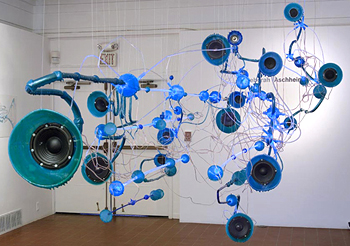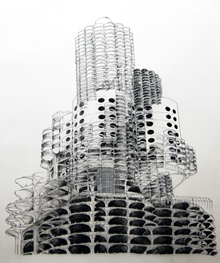
The song begins in the horn, forms at either end of this 16-foot-long structure, and moves to 14 speakers in the “body” of the piece as the music swells and distorts.
Deborah Aschheim’s art crosses boundaries and traditional subjects – she connects the invisible worlds of memory and sound with the tangible reality of bodies and buildings. Her exhibit, Method of Loci, opens at CentralTrak on Saturday, March 10, at 8 p.m.
The show takes it name from a method of memory enhancement that uses visualization to organize and recall information. The project has led her to collaborate with musicians as well as neuroscientists.
“I’m very excited to be presenting Deborah Aschheim’s work to the Metroplex. Her work illustrates a very contemporary way of incorporating scientific data and research into her studio practice,” says Heyd Fontenot, director of CentralTrak, a UT Dallas art gallery and residency in Deep Ellum.
“Her approach illustrates the nature of the Arts & Technology program at UT Dallas, so our students will enjoy it very much as well,” Fontenot says.
On display will be Aschheim’s Earworms series. The installation, produced in collaboration with musician and composer Lisa Mezzacappa, explores language and memory through sound and space.

Method of Loci will also feature new works that explore the relationship between architecture, memory and public space. Above: After Goldberg (Unrequited No. 5) 2012
“The Earworms series is named after the German word Ohrwurm, which is a fragment of song that becomes stuck in a person’s head and repeats endlessly,” Aschheim says.
“The project began as an experiment to cure aphasia by embedding words in memorable songs.”
Inspired by stories of stroke patients who had regained the ability to speak by remembering words buried in song lyrics from their past, the installations employ a list of Aschheim’s favorite words.
Mezzacappa composed and recorded a song for each word, and Aschheim built a sculpture for each song. The artists reimagine the sound and sculptural elements for each space they inhabit.
Method of Loci will also feature new works that explore the relationship between architecture, memory and public space.
“To me, modern architecture is a means to explore a narrative, drawing on the concepts of memory and history. Some of these buildings are about my same age, so they can be seen as a kind of self-portrait,” says Aschheim.
Aschheim has a master’s degree in fine arts from the University of Washington and a bachelor’s degree in anthropology and studio art from Brown University.